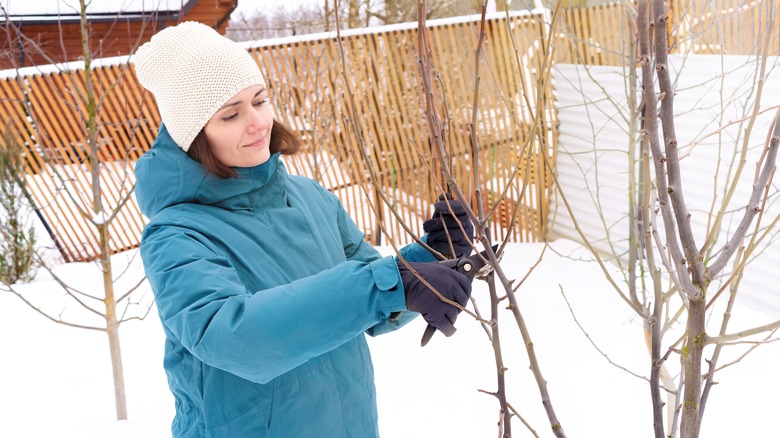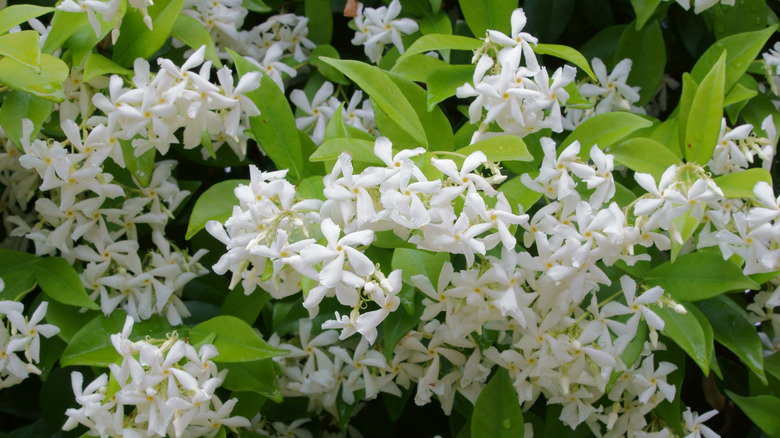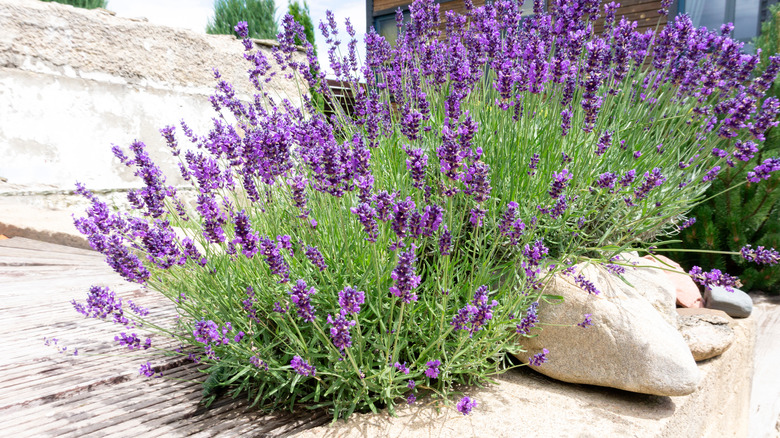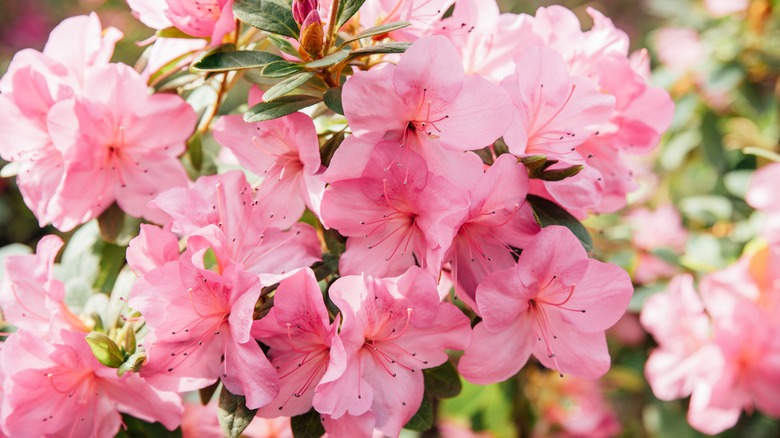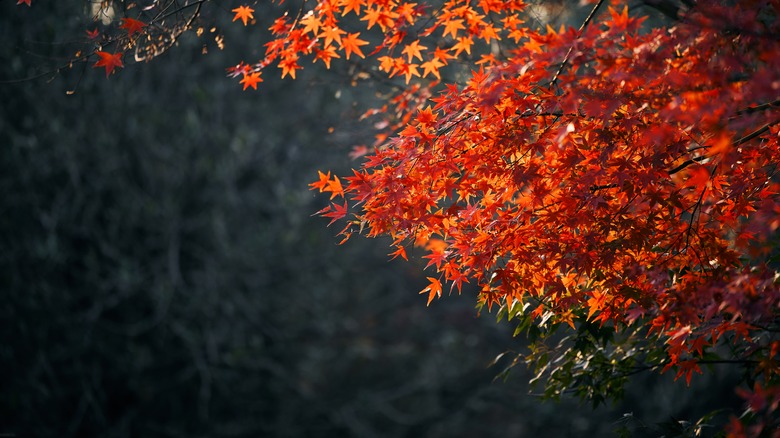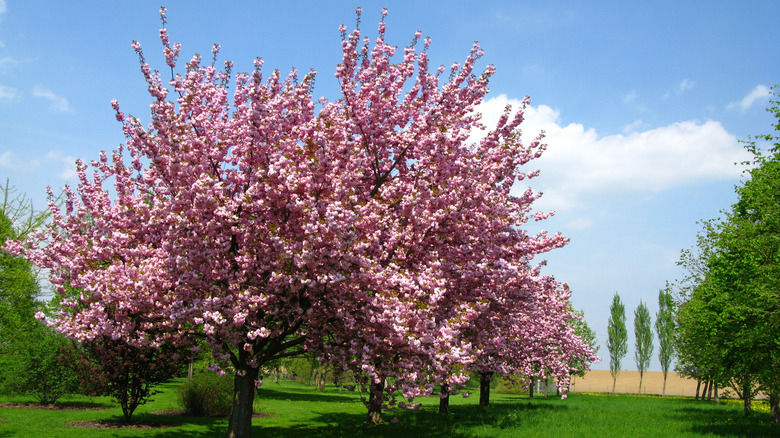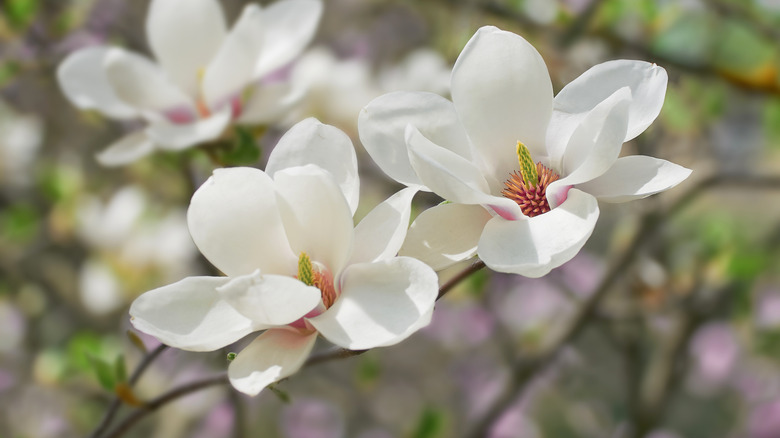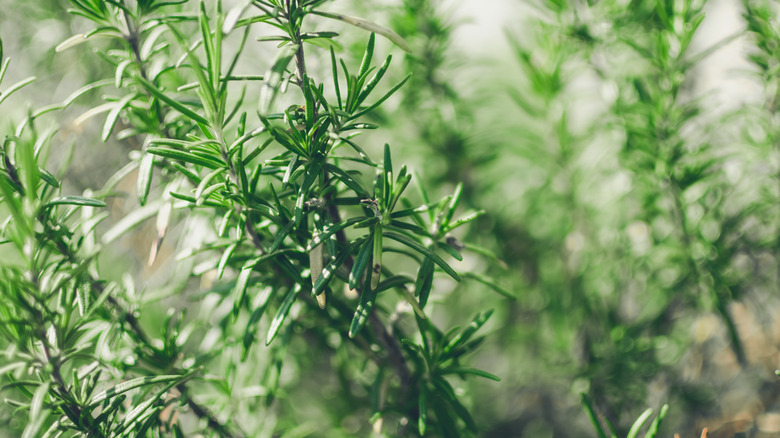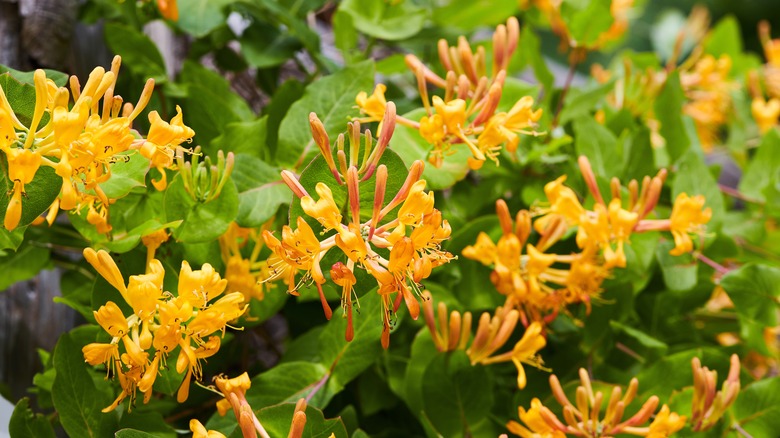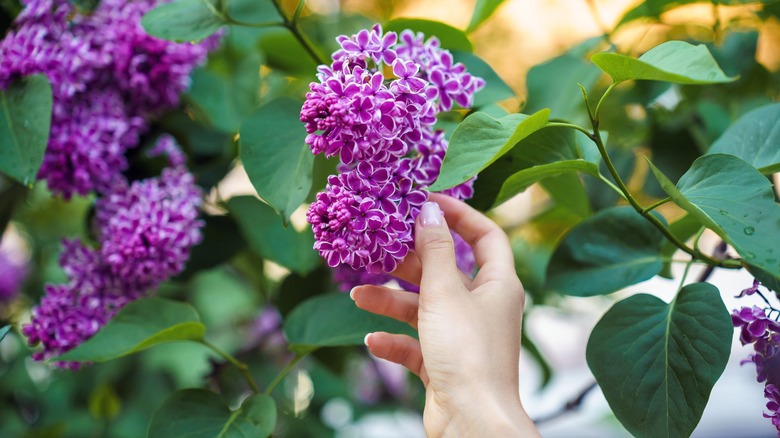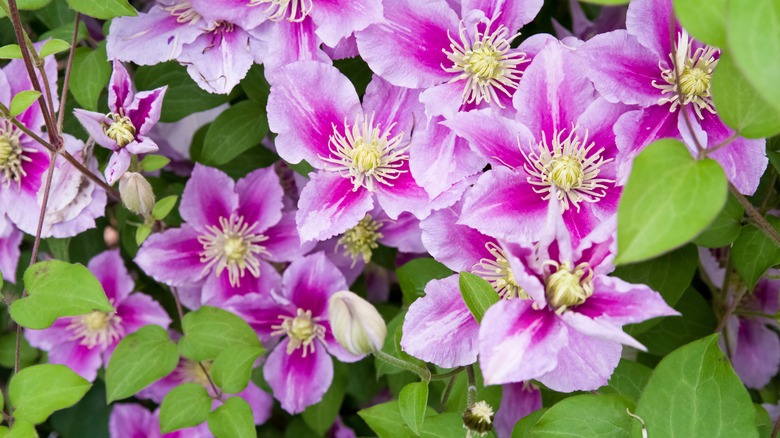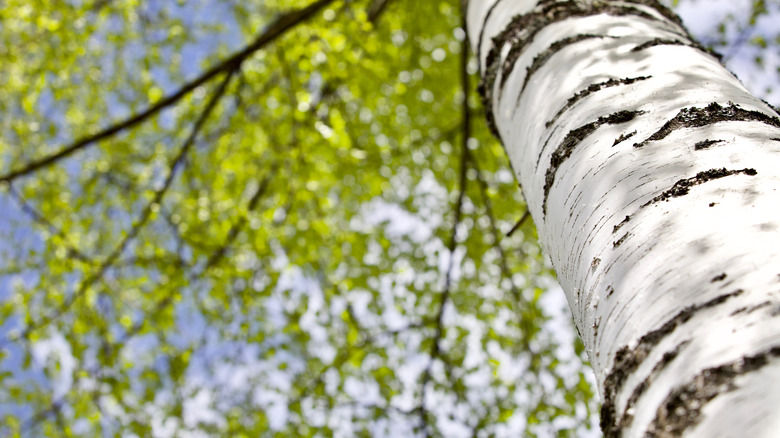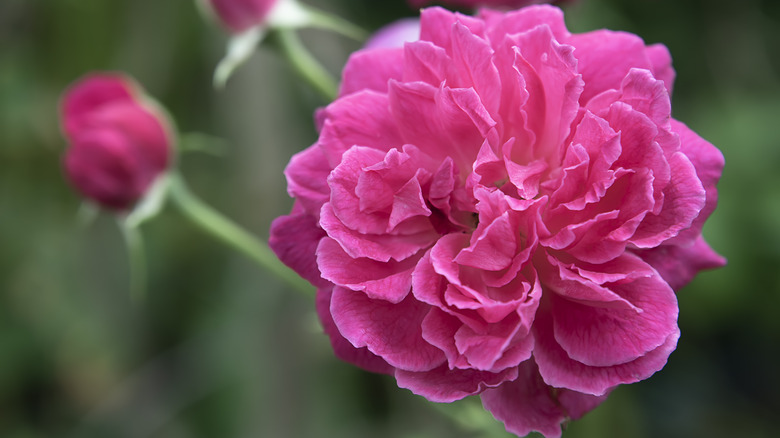Avoid Pruning These Plants In The Winter At All Costs
During the colder months of the year, after the leaves have fallen and trees look more like barren sticks than lush displays of foliage, it can be tempting to cut back branches and shape up your plants to ensure they'll be in tip-top shape once spring rolls around. For many of the trees and shrubs growing in your garden, this is a great idea, but not taking timing into account is one of the biggest mistakes to avoid while pruning your plants.
Pruning helps to increase the health of a plant, make it look more pleasing to the eye, and decrease the potential risk of rotting, dead, or weak branches, but doing so during the winter months can leave some plant species more vulnerable to pests or disease, or decrease the bloom in the following seasons. As a general guideline, flowers that bloom in the spring, trees that heavily bleed sap, and plants that don't handle cold temperatures all that well are best left alone during the coldest months of the year, but this, of course, can vary by species and the specific weather conditions of your area. By doing a bit of research into the specific care guidelines for each kind of plant you're cultivating, you'll be able to properly time your pruning so you're left with the healthiest, lushest, and most fruitful greenery on the block.
Jasmine (Jasminum officinale)
Jasmine bushes are a great choice for your garden if you're looking for a shrub that will both enhance the overall look of a space and bring some lovely fragrance to the area, but this effect is much more powerful if you prune your plant at the proper time. Jasmine should be pruned after it's done blooming, so, for most varieties, that means early fall. If you prune your summer-blooming jasmine in the winter, you'll cut off the flower's buds and effectively stop the bloom before it starts. The exception, however, is winter-blooming jasmine, which is best pruned after blooming in late winter or early spring.
Lavender (Lavandula)
Pruning lavender is essential to maintaining the plant's health and keeping it from looking unkempt and scraggly, but doing so at the wrong time of the year can leave you with more damage than good. Lavender plants can survive for years when properly maintained, but they're not the biggest fan of chilly winter temperatures. Pruning your lavender plant right before a frost or while the weather is cold can encourage new growth in a less-than-ideal season, which can leave the plant more vulnerable to frost and dipping temperatures than if it were left alone until the warmer months of the year.
Azaleas (Rhododendron)
Azaleas — and their cousins, rhododendrons — are beautiful shrubs that produce a show-stopping display of blooms during the spring and summer, but, when pruned in the incorrect season, might leave you with a lackluster floral display once warmer weather flows in. Similarly to summer-blooming jasmine, azaleas and rhododendrons need to be pruned right after blooms fade unless you want to risk cutting off your buds for the next year. Pruning in summer will ensure you get the best of both worlds: a well-maintained and healthy plant during its inactive season, and a colorful and vibrant display of flowers when it blooms.
Maple trees (Acer)
Maple trees are popular among people for their sugary sap that can be transformed into flavorful syrup, but this sweet substance also makes them popular with pests. The chillier months of the year are maple trees' peak "bleeding" season, so trimming back branches during winter can result in a stickier situation than you bargained for. Dripping sap can cause unpleasant stains on your tree's bark, and cutting back branches can leave your tree both attractive and vulnerable to pests and disease. To avoid this, it's best to prune in the summer and leave the plant alone in the winter — unless you're tapping to make your own syrup, of course.
Sweet cherry trees (Prunus avium)
For most fruit trees, pruning and trimming the branches in the winter when they're dormant is a good idea. Sweet cherry trees, however, require a bit of a different approach. These trees boast both a beautiful bloom and fruitful harvest, but the tradeoff is that you have to care for them with a bit more caution than some other plants. They're more prone to disease than a lot of other trees, and limbs that have been recently cut are hotspots for infection. Instead, give them a light pruning in the summer when they're less likely to develop issues.
Magnolias (Magnolia grandiflora)
Southern magnolia varieties have become a symbol of plenty of states across the South thanks to their dramatic white blooms, but proper care is necessary if you want to ensure that your tree puts on as brilliant a display as possible. Magnolias usually bloom in early spring or summer, so pruning too late in the winter can cause you to cut off buds that are just about to have their time to shine. Instead, trim magnolia trees after they bloom, around late spring into summer, to give them time to fill out again before next year.
Rosemary (Salvia rosmarinus)
Rosemary is a great plant to keep around if you want all the culinary, fragrant, and pest-repellant properties of an herb without sacrificing the general resilience and size of a regular bush. It's simple to maintain and even easier to harvest for home use, but it is important to occasionally prune your rosemary bushes to ensure that they stay healthy and look presentable. Because rosemary, like lavender, isn't the biggest fan of chilly weather, it's best to prune it in late spring after flowering so any new growth doesn't sprout while it's vulnerable to the elements.
Honeysuckle (Lonicera)
Honeysuckles are well-known for their sweet fragrance and vibrant, uniquely shaped flowers, but ensuring you have as big and lush a bloom as possible requires a bit of extra care. These plants grow both as climbing vines and more contained bushes, but neither variety should be pruned in the winter as doing so can cause you to remove the buds of flowers that would have otherwise bloomed in the following season. Instead, if your honeysuckles bloom in the spring or early summer, trim them after they flower. If they flower later in the summer, however, it's best to trim them back in spring.
Lilacs (Syringa)
The lilac is a beloved plant that fills gardens with vibrant color and sweet fragrance each spring, and properly timing your pruning can guarantee that your bloom will impress once the ground defrosts and warmer temperatures have returned. Because they're spring-blooming plants, pruning them in winter will likely only leave you disappointed after you've inadvertently chopped off developing buds. Instead, prune them right after they finish flowering so you're able to enjoy the gorgeous display of springy color and floral fragrance without sabotaging your plant's development throughout the coming months.
Clematis (Clematis)
For some plants, pruning is only necessary if you want to take care of a few less-than-stellar branches, but with a clematis plant, this process is a little more important. If you bypass pruning, your plant will likely look tangled and unkempt with significantly fewer flowers than if it were properly maintained. Deciding when to prune, however, depends on when your plant blooms. If they bloom in the spring, cut them back after flowering if necessary. If they bloom twice, once in early summer and again later, prune in late winter. Finally, if they bloom in late summer, prune in March.
Birch trees (Betula)
Maple trees might be better known for their heavy production of sap that's then transformed into syrup, but birch trees fall into the category of heavy winter "bleeders" too. Because of this, it's best to leave them alone in the winter, even if you're only pruning back a few branches that are starting to look scraggly. Instead, it's best to prune birch trees during the warmer months of the year, usually around August or September for best results. Pruning in winter can also leave birch trees especially vulnerable to birch borers during their egg-laying season, which can easily result in serious issues down the line.
Damask roses (Rosa damascena)
Most roses do well when pruned during the winter, but summer-blooming damask roses are the exception. These lush, vibrant flowers only bloom once a year during the summer months and only bloom on old wood, so properly timing your pruning — right after your plant flowers — is essential to guarantee that you're left with as many blooms as possible the following year. Pruning is also incredibly important for damask roses because they frequently fall victim to disease. Removing any dead or damaged branches will not only make your plant look more aesthetically pleasing, but it will improve its overall health.
